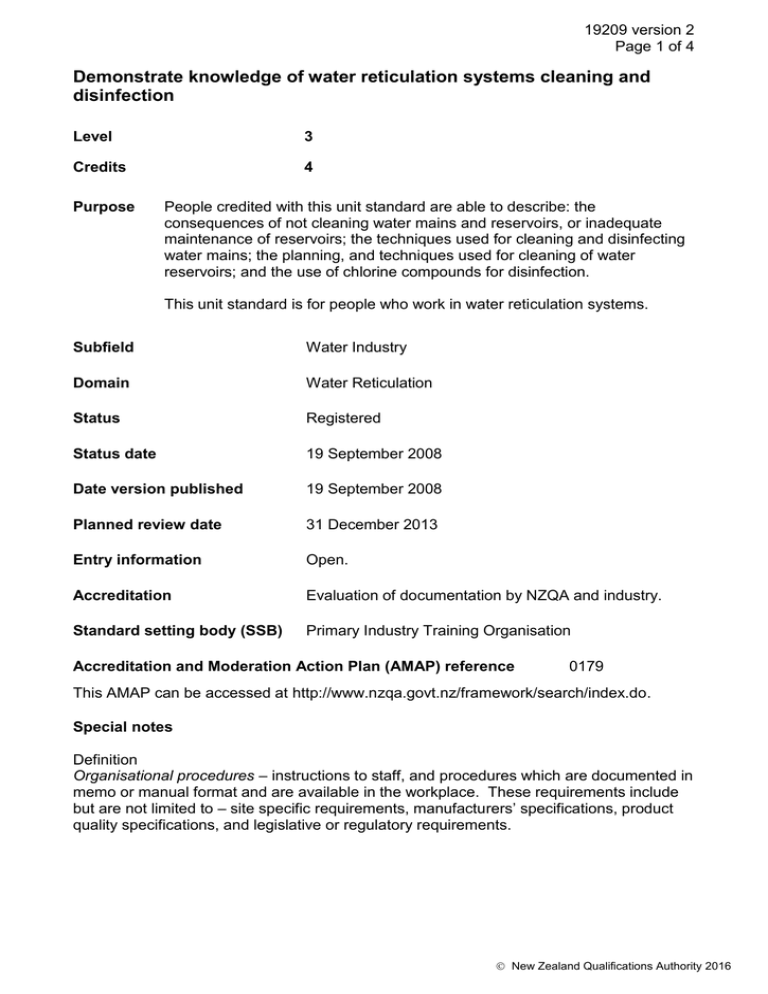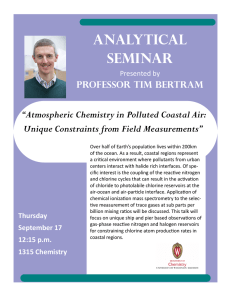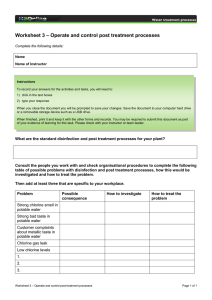Demonstrate knowledge of water reticulation systems cleaning and disinfection
advertisement

19209 version 2 Page 1 of 4 Demonstrate knowledge of water reticulation systems cleaning and disinfection Level 3 Credits 4 Purpose People credited with this unit standard are able to describe: the consequences of not cleaning water mains and reservoirs, or inadequate maintenance of reservoirs; the techniques used for cleaning and disinfecting water mains; the planning, and techniques used for cleaning of water reservoirs; and the use of chlorine compounds for disinfection. This unit standard is for people who work in water reticulation systems. Subfield Water Industry Domain Water Reticulation Status Registered Status date 19 September 2008 Date version published 19 September 2008 Planned review date 31 December 2013 Entry information Open. Accreditation Evaluation of documentation by NZQA and industry. Standard setting body (SSB) Primary Industry Training Organisation Accreditation and Moderation Action Plan (AMAP) reference 0179 This AMAP can be accessed at http://www.nzqa.govt.nz/framework/search/index.do. Special notes Definition Organisational procedures – instructions to staff, and procedures which are documented in memo or manual format and are available in the workplace. These requirements include but are not limited to – site specific requirements, manufacturers’ specifications, product quality specifications, and legislative or regulatory requirements. New Zealand Qualifications Authority 2016 19209 version 2 Page 2 of 4 Elements and performance criteria Element 1 Describe the consequences of not cleaning water mains and reservoirs, or inadequate maintenance of reservoirs. Performance criteria 1.1 The impacts of detritus build up in water supply mains and reservoirs are described in terms of protection of microbes from disinfectants. Range 1.2 shielding from chlorine, colonisation of surfaces. The opportunities for contamination due to inadequate reservoir maintenance or security are described in terms of water quality risks and methods to reduce these risks. Range includes but is not limited to – protective equipment, site cleanliness, washing, disinfection, construction and security requirements. Element 2 Describe the techniques used for cleaning and disinfecting water mains. Performance criteria 2.1 The use of flushing flows is described in terms of their cleaning efficiency. Range 2.2 The use of air scouring flows is described in terms of their cleaning efficiency. Range 2.3 air introduction, detritus removal, dead spots, recesses, flow availability, scour velocity, pipe surface condition. The use of swabbing is described in terms of cleaning efficiency. Range 2.4 detritus removal, dead spots, flow availability, scour velocity, pipe surface condition. swab and pig types, swab recovery, detritus removal, recesses, flow availability, scour velocity, pipe surface condition. The use of chlorination following main laying or repair is described in terms of the techniques available. Range single fill/hold technique, flow through technique. New Zealand Qualifications Authority 2016 19209 version 2 Page 3 of 4 Element 3 Describe the planning, and techniques used, for cleaning water reservoirs. Performance criteria 3.1 The reservoir cleaning plan is described in terms of the time taken, and the sequence of operations. 3.2 The use of equipment is described in terms of cleaning efficiency. Range 3.3 The use of a disinfectant following cleaning is described in terms of the efficiency of the technique, and safety requirements. Range 3.4 water blasters – limitations on jet size and effective reach, detritus removal, surface effects, disposal of water flows. dose levels, contact times, need for prior detritus removal, disposal of dosed water. The opportunities for contamination during cleaning are described in terms of water quality risks, and methods to reduce these risks. Range includes but is not limited to – positive water flows, site cleanliness, trench inundation, flushing, pigging, disinfection, air scouring, personal hygiene. Element 4 Describe the use of chlorine compounds for disinfection. Performance criteria 4.1 The forms of chlorine available are described in terms of their effectiveness, and safety issues. Range 4.2 The application of chlorine compounds is described in terms of concentration, dilution, and safe handling. Range 4.3 chlorine gas, calcium hypochlorite (HTH), sodium hypochlorite (bleach), isocyanuric acid (pool tablets). chlorine gas, calcium hypochlorite (HTH), sodium hypochlorite (bleach), isocyanuric acid (pool tablets). The concept of contact time is described in terms of disinfection effectiveness. Range Ct values, typical values, strength of different chlorine forms, vulnerability to high pH levels, g/m3, check tests. New Zealand Qualifications Authority 2016 19209 version 2 Page 4 of 4 4.4 The impacts of releasing highly chlorinated water are described in terms of the receiving environment, sewage plants, and consumers in water reticulation. Range 4.5 The safety procedures and equipment used when handling chlorine compounds are described in terms of organisational procedures. Range 4.6 manufacturer’s Material Safety Data Sheets, safety goggles, face shields, eye wash, protective clothing, self-contained breathing apparatus. The storage of chlorine compounds is described in terms of safety procedures. Range 4.7 aquatic life systems, sewage micro-organisms. chlorine gas, calcium hypochlorite (HTH), sodium hypochlorite (bleach), isocyanuric acid (pool tablets). The neutralisation of chlorine prior to discharge to waste is described in terms of the techniques used. Range evidence is required for at least one technique. Please note Providers must be accredited by NZQA, or an inter-institutional body with delegated authority for quality assurance, before they can report credits from assessment against unit standards or deliver courses of study leading to that assessment. Industry Training Organisations must be accredited by NZQA before they can register credits from assessment against unit standards. Accredited providers and Industry Training Organisations assessing against unit standards must engage with the moderation system that applies to those standards. Accreditation requirements and an outline of the moderation system that applies to this standard are outlined in the Accreditation and Moderation Action Plan (AMAP). The AMAP also includes useful information about special requirements for organisations wishing to develop education and training programmes, such as minimum qualifications for tutors and assessors, and special resource requirements. Comments on this unit standard Please contact the Primary Industry Training Organisation standards@primaryito.ac.nz if you wish to suggest changes to the content of this unit standard. New Zealand Qualifications Authority 2016




